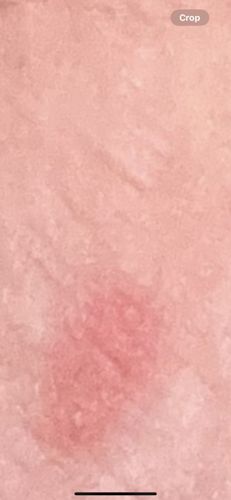Tick (specifically, the image shows a bite mark, which is most consistent with a tick bite given the typical appearance of a localized red area often without a central bite mark visible after detachment)
Scientific Name: There are many species of ticks; common genera include Ixodes, Dermacentor, Amblyomma, Rhipicephalus, and Argas. Without the tick itself, a specific scientific name cannot be assigned.
Order & Family: Order: Ixodida (or Acari, suborder Ixodida); Family: Ixodidae (hard ticks) or Argasidae (soft ticks)
Size: Unfed larvae are often less than 1 mm, nymphs are 1-2 mm, and adult ticks can range from 2-10 mm, depending on the species and whether they are engorged with blood.

Natural Habitat
Wooded areas, tall grasses, brush, and leaf litter. They are found in both urban and rural environments globally.
Diet & Feeding
Blood of mammals, birds, reptiles, and amphibians.
Behavior Patterns
Ticks are obligate parasites and spend most of their life cycle off-host. They typically climb onto vegetation and wait for a host to pass by (questing behavior). Once on a host, they seek a suitable spot to attach and feed. They can feed for several days, engorging significantly. After feeding, females drop off to lay eggs. Their life cycle includes egg, larva, nymph, and adult stages, each requiring a blood meal.
Risks & Benefits
Risks: Ticks are significant vectors of various diseases, including Lyme disease, Rocky Mountain spotted fever, anaplasmosis, ehrlichiosis, babesiosis, and Powassan virus, among others. Tick bites can also cause allergic reactions or local skin irritation. Benefits: While not directly beneficial to humans, ticks play a role in natural ecosystems as part of the food chain, albeit a minor one, and as parasites that can influence host populations.
Identified on: 9/4/2025